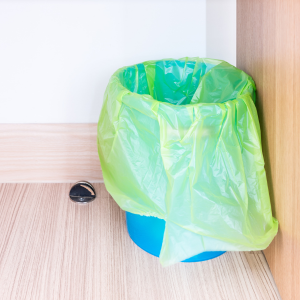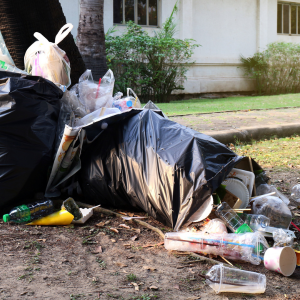Why Do My Bin Liners Keep Ripping? (And How to Fix It)
Ripped bin liners aren’t just annoying—they’re messy, unhygienic, and surprisingly costly for businesses. Whether it’s the cleaner cursing under their breath or the admin staff dodging leaking coffee grounds on their way to the printer, torn liners are a bigger deal than you think. In this blog, we’ll unpack the reasons why your bin bags might be failing and share simple, effective ways to stop the ripping once and for all.
Why Bin Liners Rip (And Why It Matters)
It’s easy to assume all bin liners are the same… until one splits wide open mid-disposal. Not only is it unpleasant (hello, bin juice), but it can also:
-
Increase cleaning costs
-
Create hygiene issues
-
Interrupt workflows
-
Lead to waste sorting problems (especially with recyclables and compostables)
Choosing the wrong bag can cost more than choosing the right one.
Common Causes of Ripped Bin Liners
1. Bag Thickness (Micron Rating) is Too Low
Thinner bags = lower durability. Microns measure bag thickness, and anything under 20 microns may struggle with everyday office waste. Choose thicker bags for heavier or more irregular waste. See here for a quick quide to our bags.
2. The Bag is Too Small for the Bin
If you're stretching a small liner to fit a large bin, you're practically inviting a tear. Overstretching weakens the material and stresses the seams. Of course a bag that is too big for your bin is a waste of money (and plastic).
Need help choose the right size bag for your bin? This blog on Choosing the Right Size Rubbish Bag gives you more info.
3. Wrong Type for the Waste
Using a lightweight bag for sharp or heavy waste (like broken mugs or packaging offcuts) is like bringing a paper umbrella to a storm. Use heavy-duty or puncture-resistant bags for rough waste.
4. Poor Quality or Inconsistent Suppliers
Some bags are just... bad. Low-quality materials, poor sealing, or inconsistent production standards can make rips a regular occurrence.
What You Can Do: Actionable Fixes
✅ Choose the Right Micron Rating
For office use, a 20–30 micron rating works well for general waste. Go 30–50+ microns for heavier industrial or food waste.
✅ Match Bag Size to Bin Size
Use our bin liner sizing guide to ensure a good fit. Too small? It’ll tear. Too big? It’ll bunch and slip.
✅ Use Colour-Coded Bags
This helps staff choose the right type for each bin (e.g., compostable for organics, clear for recycling, black for landfill). Less confusion = fewer rips.
✅ Buy from a Reliable Supplier
Choose a trusted supplier (ahem like us at Insinc) who offers consistent quality, customer support, and eco-friendly options that won’t fall apart.
Stronger liners + the right size = no more mess.
✅ Bin Liner Checklist: Are You Using the Right One? |
|
Size Matters Thickness (Microns) Material Type Bag Colour & Type Stock & Supplier Bonus Tips |
Download Our Free Checklist: Are You Using the Right Bin Liner?
Want a quick way to check if your bin liner is up to the job? Download our free printable checklist to see if you’re making any common mistakes—and how to fix them.
Click here to download the checklist
(We won't make you sign up for anything. You're welcome.)
Frequently Asked Questions (FAQ)
1. How do I know what size bin liner I need?
Start by measuring the height and width of your bin. The liner should be wide enough to cover the rim and tall enough to allow for overhang, so you can tie it off easily. We have a helpful bin liner sizing guide on our rubbish bags page to make it easy.
2. Are compostable bin liners strong enough for office use?
Yes, compostable bin liners are absolutely strong enough for general office waste like tissues, paper towels, and lunch wrappers—especially if you choose the right size and thickness (aim for 20–25 microns or more).
But here’s the catch: because they’re made to break down (that’s the whole point!), they don’t love moisture. If you’re tossing in soggy food scraps, leftover coffee, or anything particularly wet, the liner can start to weaken and break down faster than expected.
For dry waste, they hold up beautifully. For wet waste, it’s best to empty bins more regularly or line the bottom with some paper to soak up moisture and keep things tidy.
Buy compostable bin liners here
3. What does “micron rating” mean in rubbish bags?
The micron rating tells you how thick the bag is. Higher microns mean thicker and stronger bags. For example, 20–25 microns is usually fine for general office use, while 30+ microns are better for heavy or bulky waste.
4. What’s the best type of bin liner for general office waste?
For a standard 27–30L bin, a 30L liner with a 20–25 micron thickness works well. For heavier waste or where hygiene is a concern (like in kitchen bins), go for thicker bags (30+ microns) and make sure they fit the bin snugly to avoid slippage. Our chart of bag sizes gives you a quick oveview of what is available.
Bin Liner Woes, Be Gone!
Choosing the right bin liner might seem like a small thing—but it can make a big difference to cleanliness, efficiency, and even sustainability in your workplace. By paying attention to size, thickness, material, and usage, you can avoid the dreaded rip, keep things hygienic, and support your environmental goals at the same time.
Whether you're running a busy office, a bustling café, or a quiet shared space, there’s a perfect liner for every bin—and we’re here to help you find it. No mess, no stress, just tidy bins and happy staff.
Got questions or want to explore our full range of bin liners? Check out our rubbish bags here or give us a shout—we’re always happy to help!
Posted: Tuesday 20 May 2025


